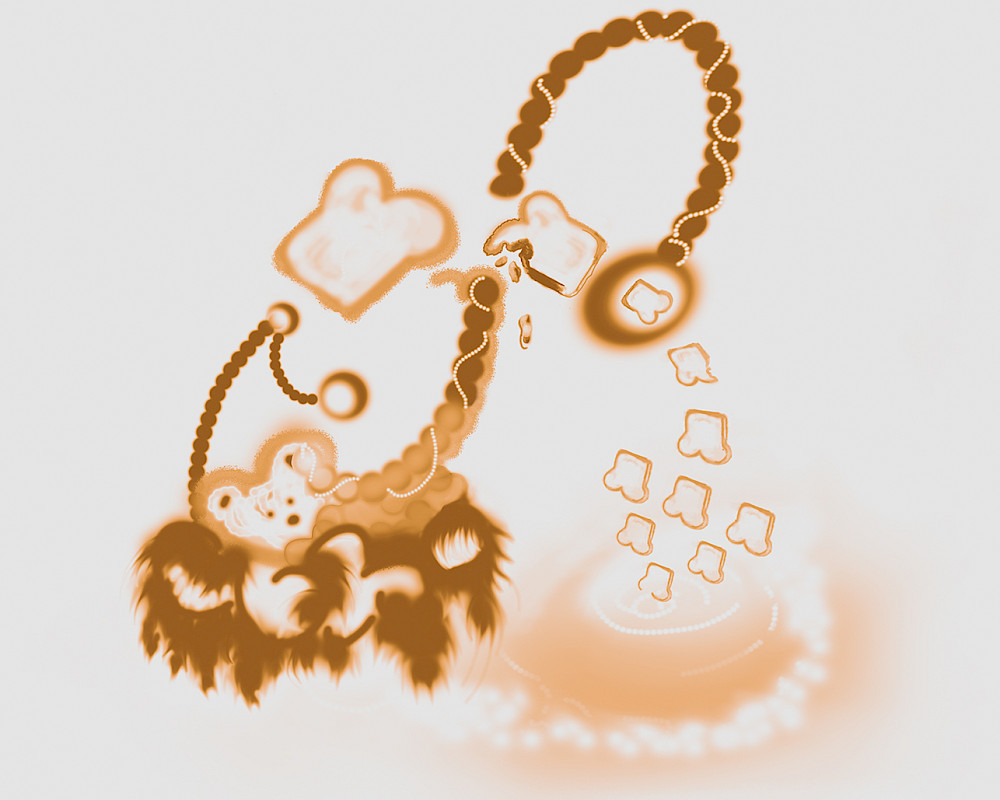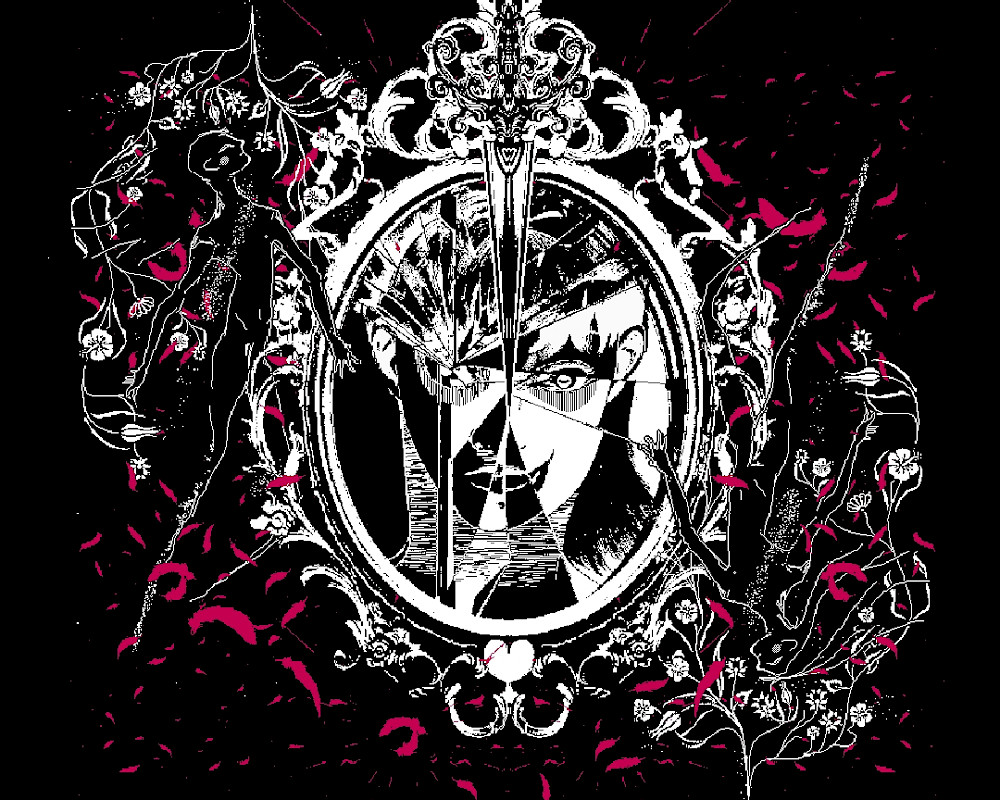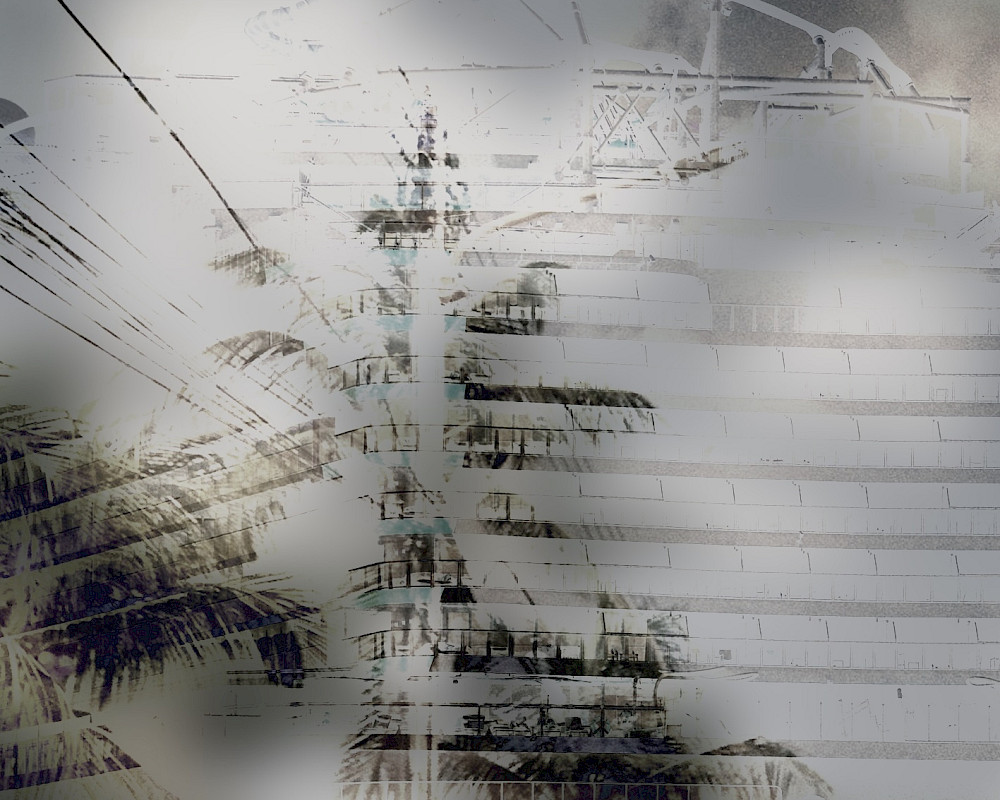essay
Mystics of the Chthulucene
Maia Kenney
Maia Kenney is an art historian, curator and critic specialised in feminist underpinnings of modernist art movements (and a proponent of the destruction of Modernism as a Eurocentric storytelling device). She is the digital curator and editor of The Couch, and teaches theory in the Master of Contextual Design at Design Academy Eindhoven.
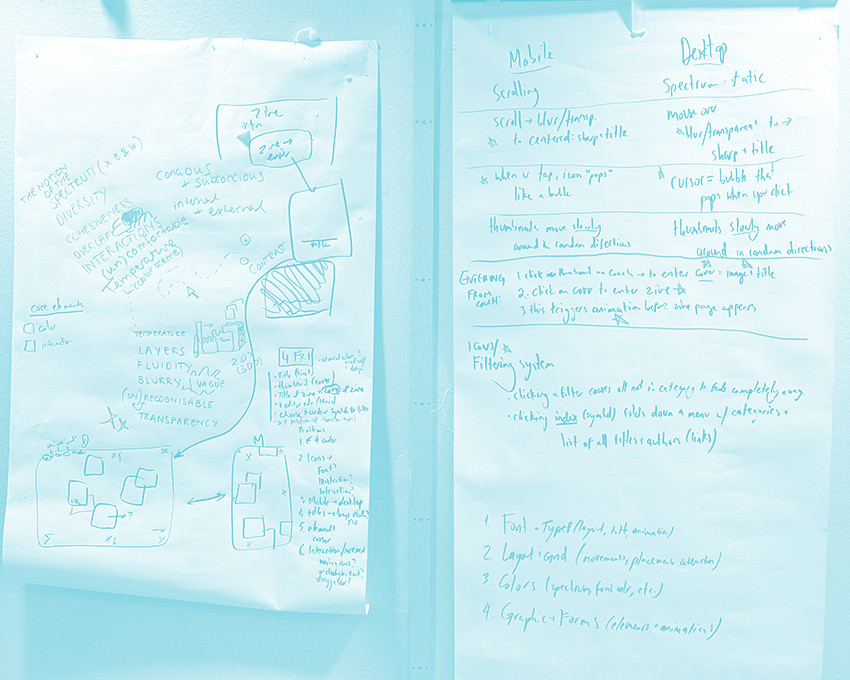
letter
Editor's Note

letter
A letter from my couch
2023 in review, and a few hints on what’s in store for The Couch in 2024.

interview
Learning Space
"I started thinking in an almost choreographic way about music inside this building as it moved from the basement out onto the factory floor and beyond." Couch curator Maia Kenney interviews Orpheu de Jong, Music Curator of Het HEM, in a deep-dive into Het HEM's music programme and its relationship with the building's architecture.
Rustan Söderling
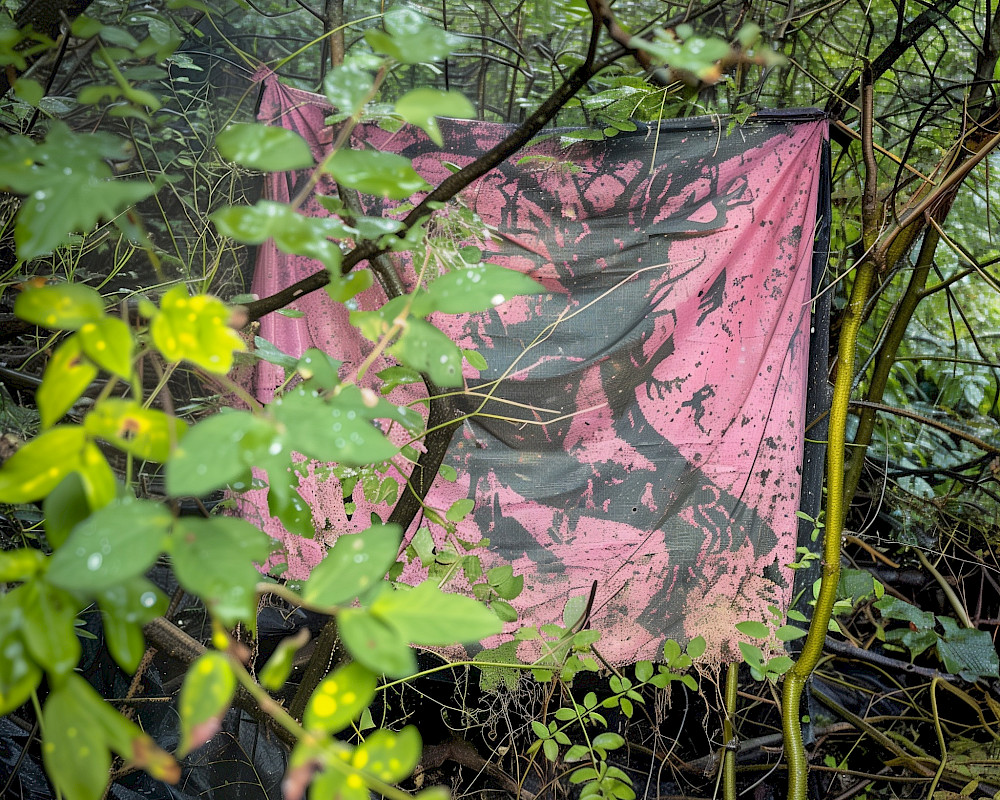
music
Singing To The Machine: Orpheu The Wizard
This mix by Orpheu The Wizard consists of a selection of songs loosely revolving around the themes of Mystics of the Chthulucene. First up in a new mix series, where artists, selectors, and music geeks connect sounds to a broader and recurring artistic research theme that weaves through The Couch.
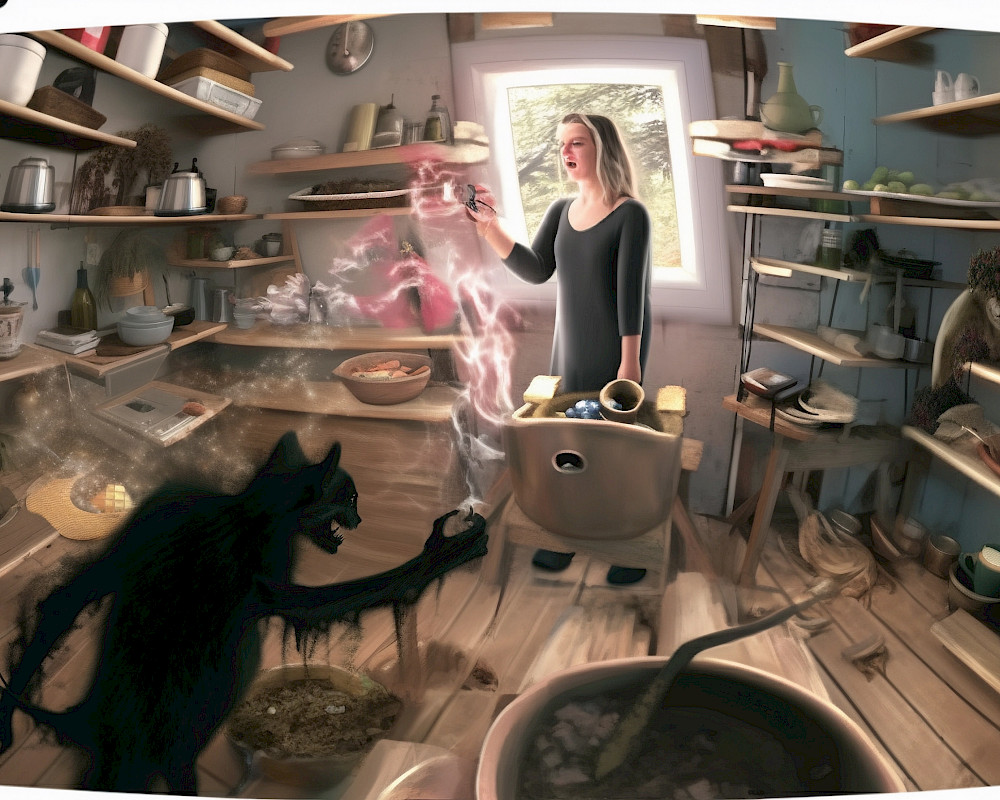
essay
Are TikTok Healers Contemporary Quacks or Re-risen Witches*?
Are the countless self-proclaimed ‘healers’ giving medical advice on TikTok quacks? Or are they a sign that witches* have reclaimed their space in the health field, reviving lost knowledge and offering the care that mainstream healthcare still fails to provide?
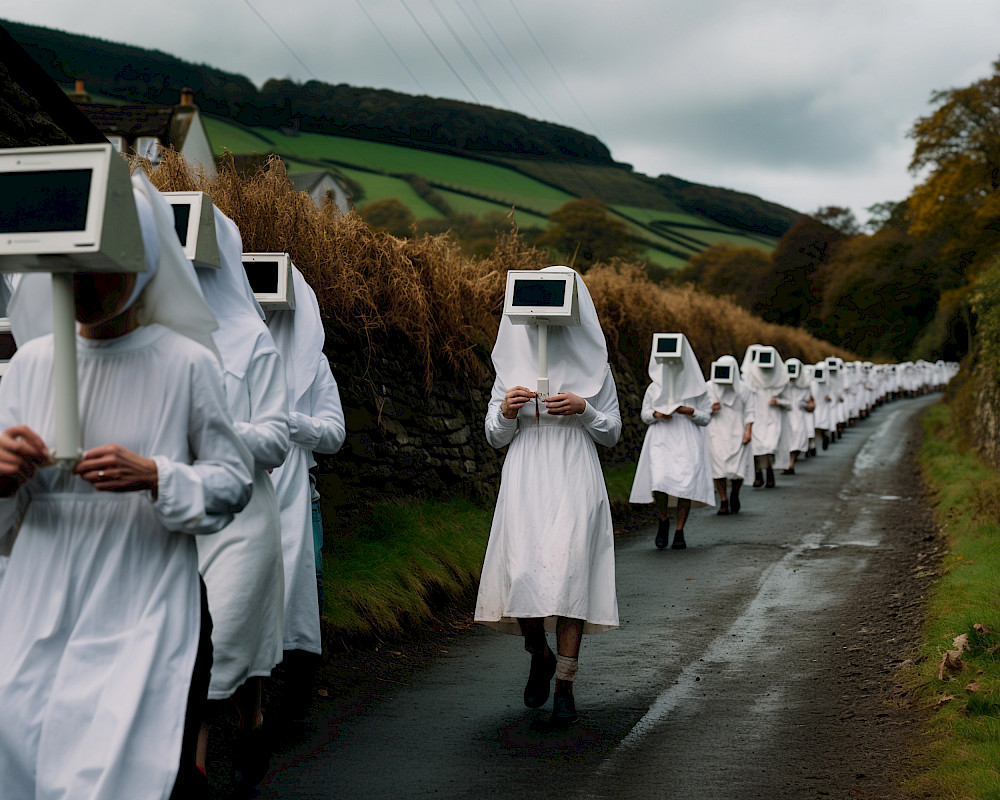
essay
The mindless sc/troller
If the postmodern (digital) experience is a similarly disorienting experience to that of the modern flâneur, then is it possible to adopt the same approach to the web as to the city, where the mind can freely wander and transform?

essay
POV:
Ginevra Petrozzi makes the case for a complicated relationship between ourselves and the artificial intelligence tools that guide us through our lives. The stories and myths we construct around the technologies we don’t understand can help us navigate the obscure and even violent power of artificial intelligence.
18
min read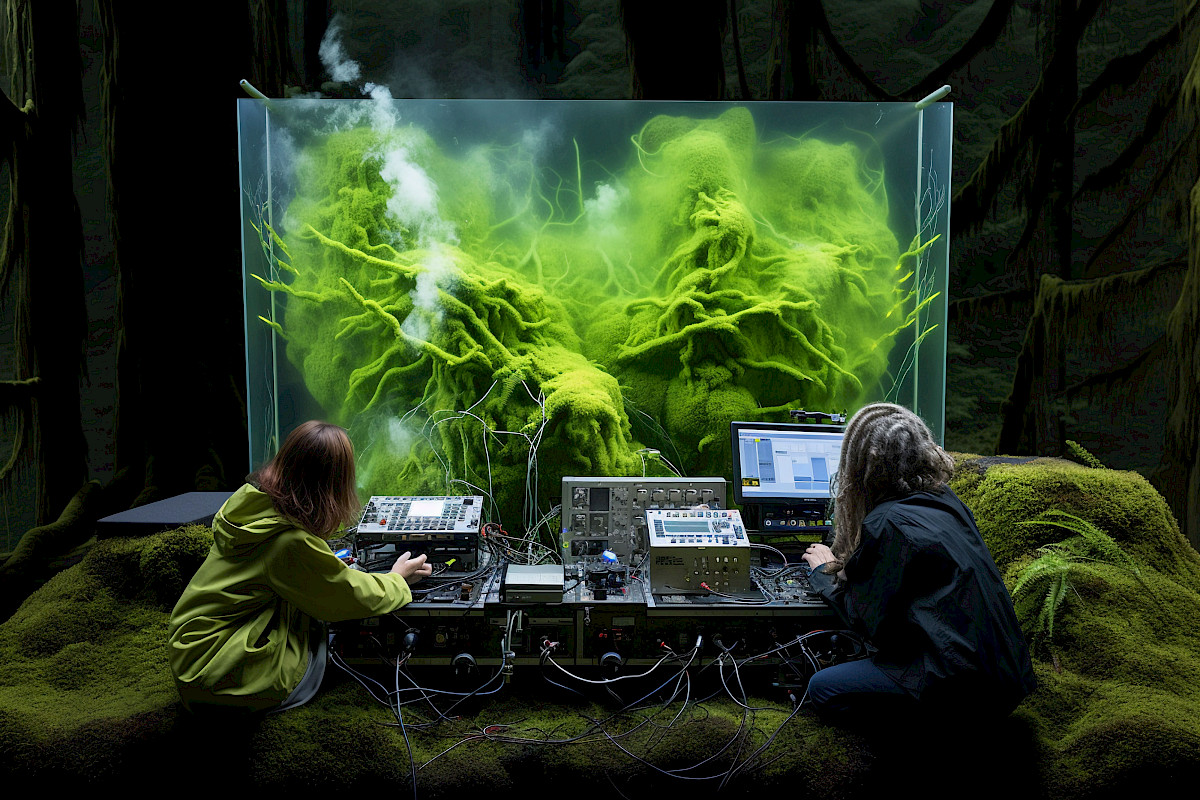
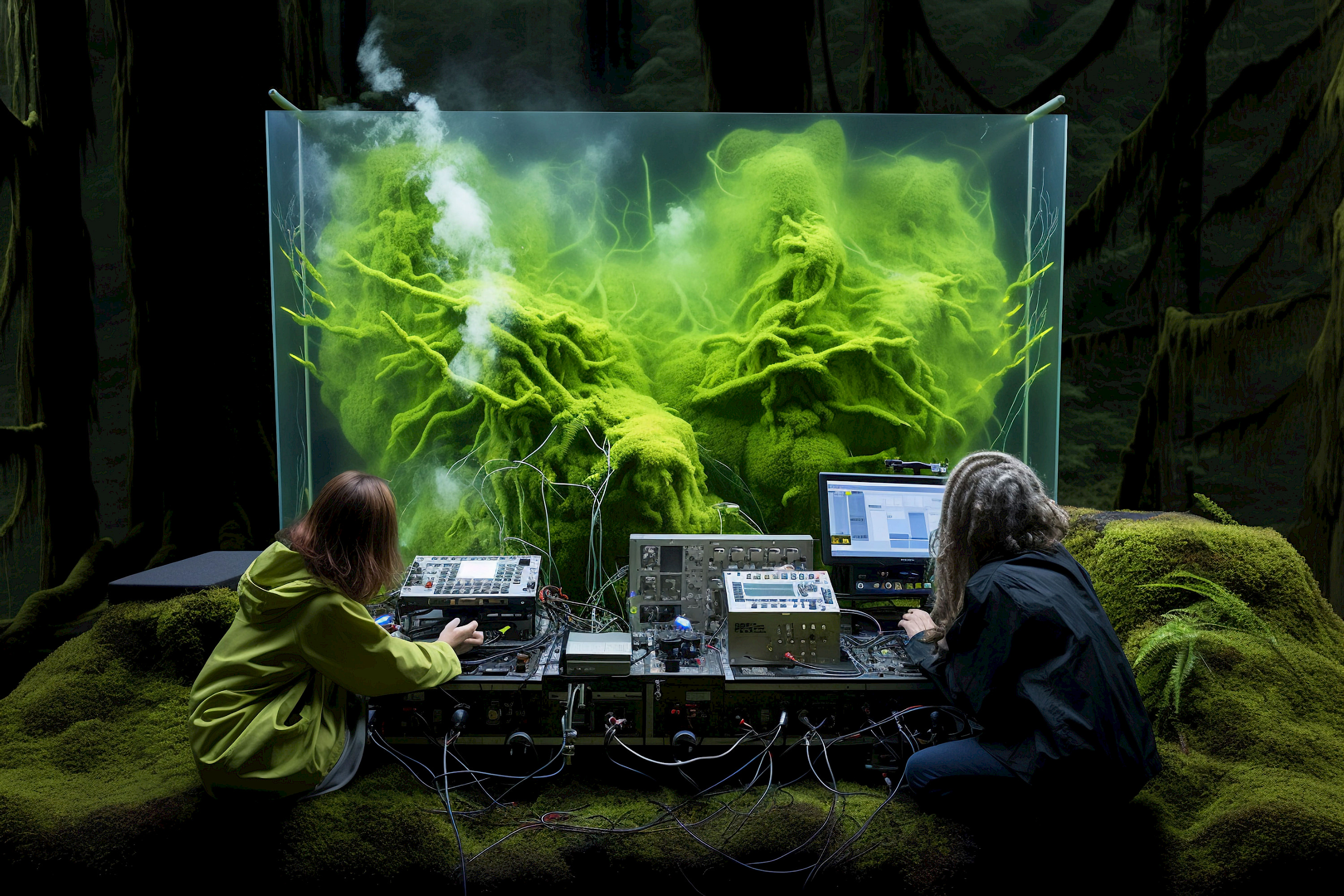
When I was a kid, my grandmother subscribed to an (admittedly terrible) astrology magazine called Wróżka (fortune teller but also fairy, in Polish). Tips for gathering medicinal herbs, short articles asking ‘who needs a husband, anyway?’, divination methods – these were the watered-down magical practices acceptable for women in 1990’s Poland. But beneath Wróżka’s garish ads and recipes for ‘feel-good cookies’ were snippets of Polish folklore and remnants of witchcraft and spellcraft from what felt like a time before the industrial revolution. Its undercurrents of feminism – developed, surely, as my grandmother’s, on the picket lines in communist Poland – still managed to poke through its pink and cutesy newsstand cover.
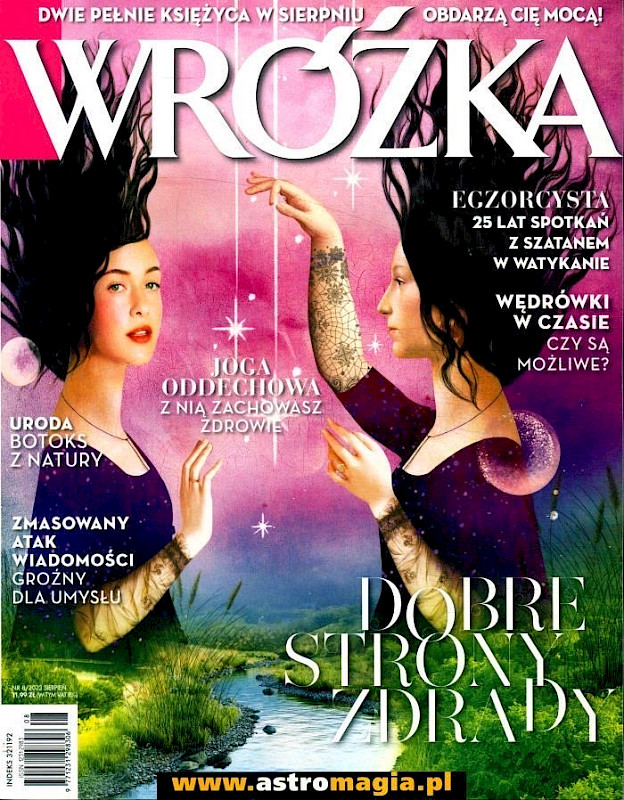
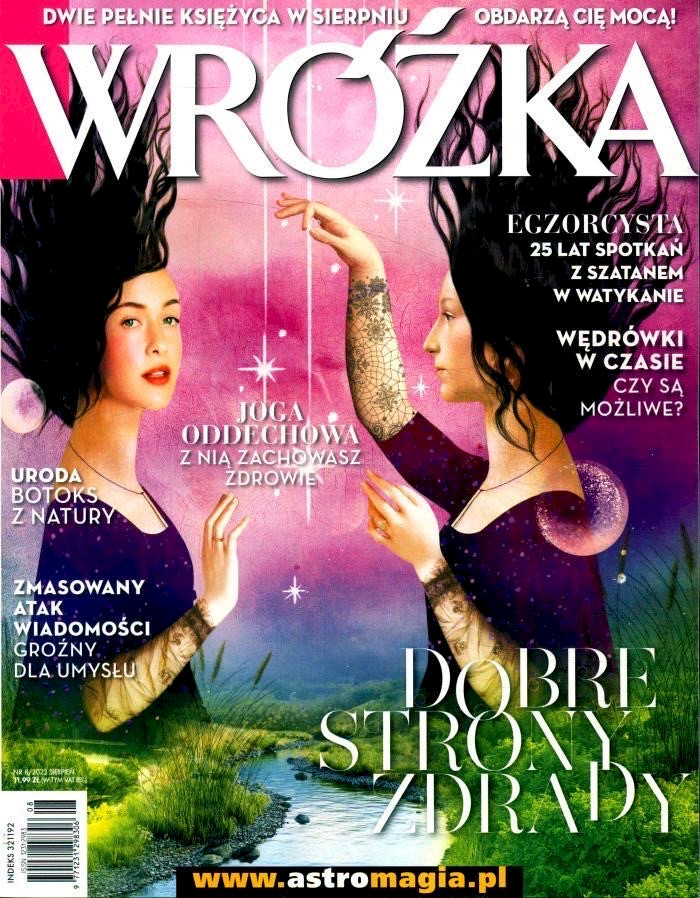
I didn’t think much of this magazine, so I set it aside. It’s only now that I see my grandmother’s seemingly endless knowledge of edible plants and mushrooms, her strange concoctions (bee pollen vodka, anyone?) and hilarious atheist mentality so rare in rural Poland, for what they are: skills of magic. Not magic with a capital M, not magicK, not sorcery or the occult. Not alchemy, wizardry or black or white magic, not really Wicca, divination or spiritualism. More like: witchcraft, hedge magic. Spells for the everyday. A woman’s knowledge. A (woman’s) science.
Magic under capitalism
It has always been the case that some humans try to explain things they don’t understand - particularly invisible or unseen forces - as magical, miraculous or arcane. This lens helps us grasp the seeming impossibility of our existence and sometimes fades once we realize what is really going on. From this can come a stronger bond with reality (whatever that is). But naming something as ‘magic’ has also been associated with silencing certain voices, shutting down unwanted knowledges that threaten those who hold power. That is how ancient, pagan or indigenous magic and occult practices were violently and systematically replaced by the new natural sciences around the time of the European Enlightenment – a replacement that continues to this day. (This is, of course, a hugely simplified history.)
It is in this outsider naming, this calling something magic, that a distance is created between the signifier and signified. A responsibility is shirked: you don’t have to understand something to call it magic. Into that space seeps the possibility of violence: the refusal to attempt to understand is a severance of empathy, an othering. I bring this up because I want to highlight that there is a huge difference between proclaiming something as magic or occult (or Satanic, for the Q-Anon afficionados out there – it’s all getting very blurry) as an accusation, and conducting the practice of magic or witchcraft as a community that carries knowledge in undercurrents.
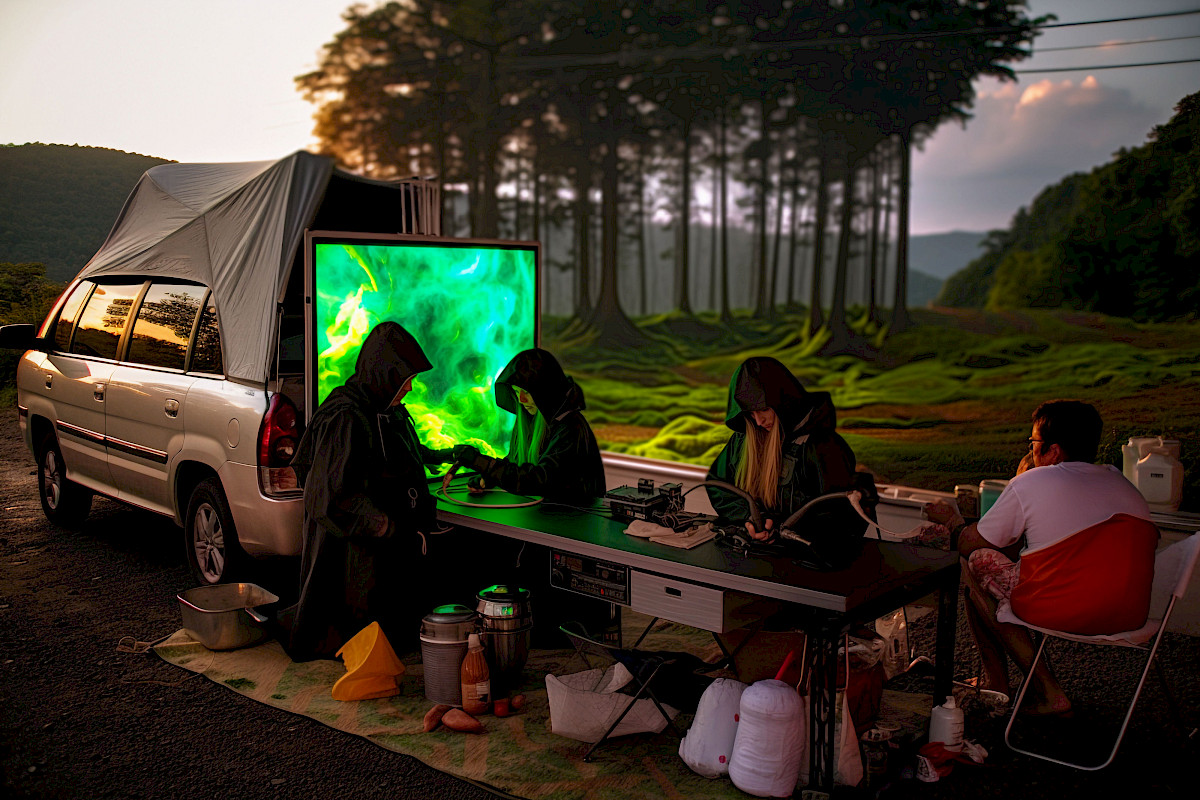
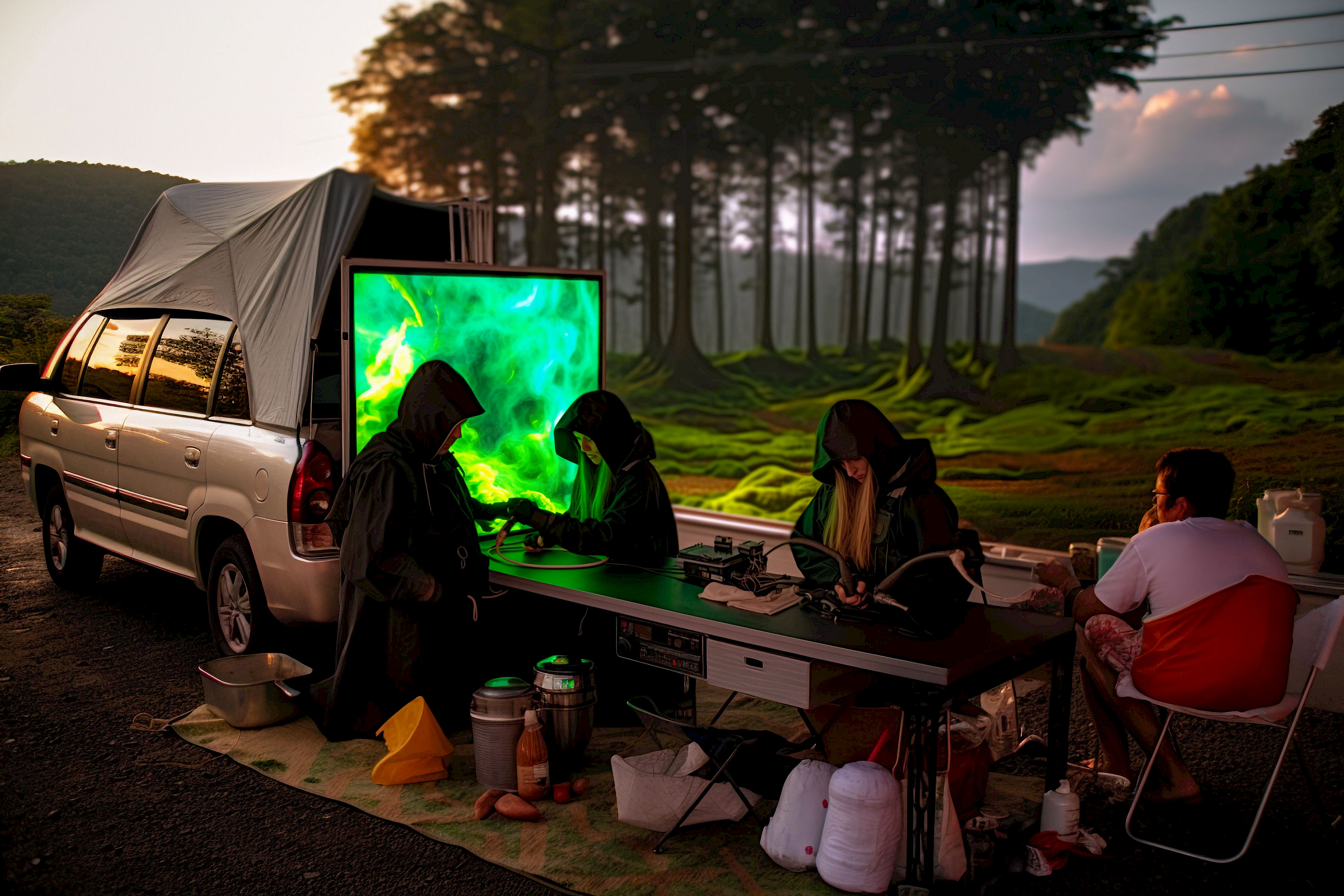
Silvia Federici argues that the witch hunts of Europe were a concerted effort to remove power from women, who (through midwifery, at least) controlled reproduction – the production of labour. Under capitalism, the devaluation of labour includes and is based on the devaluation of domestic labour; there is no alternative for an exploitative system than to control and reinforce the position of the working class. Put very simply: there is a reason why reproduction (keeping a steady and increasing population of workers) keeps capitalists up at night. Federici demonstrates that, in some places in Europe, all paid work by women was banned (and denounced as immoral): women seeking money was sure proof of making a pact with the devil. Naming midwifery and women’s work in general as witchcraft – and therefore creating a moral ‘reason’ for its banning under both Church and Enlightenment principles – is a fundamental step in alienating and subduing women.
But let’s indeed take magic in the sense of knowledge production, if that’s what’s being forced on us. Then, the witch hunts of Europe and its colonies have much in common with, for example, the attempted total cultural re-education of indigenous people in North America in the 20th century. Proscribed knowledge poses a danger to a governing body which can apparently only respond with violence: Ban ‘magic’. Ban dance and music. Ban midwifery. Ban language. Ban abortion. Ban queer literature and drag. It’s no coincidence that 21st century ‘witches’, occultists, revivers of indigenous knowledges wave anti-capitalist, feminist liberation as their battle flag. There is no alternative.
But with the absolute vanguard of new practitioners, which reaches at least to late 19th-century spiritualism, the start of Wicca and its links to early feminist movements, and now a massive (and social media-friendly) explosion of interest in the occult, the question is still: what is magic? A science? Is it a technology? Again, founded in reproductive health and autonomy and persecuted as such, I’d argue yes, it’s both. Consider a second layer of lore around magic: it’s language, the power of naming things. Taxonomy. And a third: it’s the unknown, the always ungraspable – something like a layperson’s understanding of how any advanced science or technology works.
The 21st-century magician and comic book author Alan Moore argues that magic can “no more be considered as a true science than can, say, psychoanalysis”, because it skips too many steps between cause and effect (1). I appreciate this argument because it’s true, in the sense that alchemy and certain kinds of sorcery want immediate results: gold from mercury, a demon to do your bidding. But this is somewhat simplistic, or maybe too rooted in the specific type of revivalist occultism Moore refers to. I’m more inclined to imagine midwives laboriously testing herbs and medicines over time and leave miracles to the superstitions of the Catholic Church. We may see or experience magic as a shortcut, but it isn’t: its development was a process, an esoteric version of the scientific method.
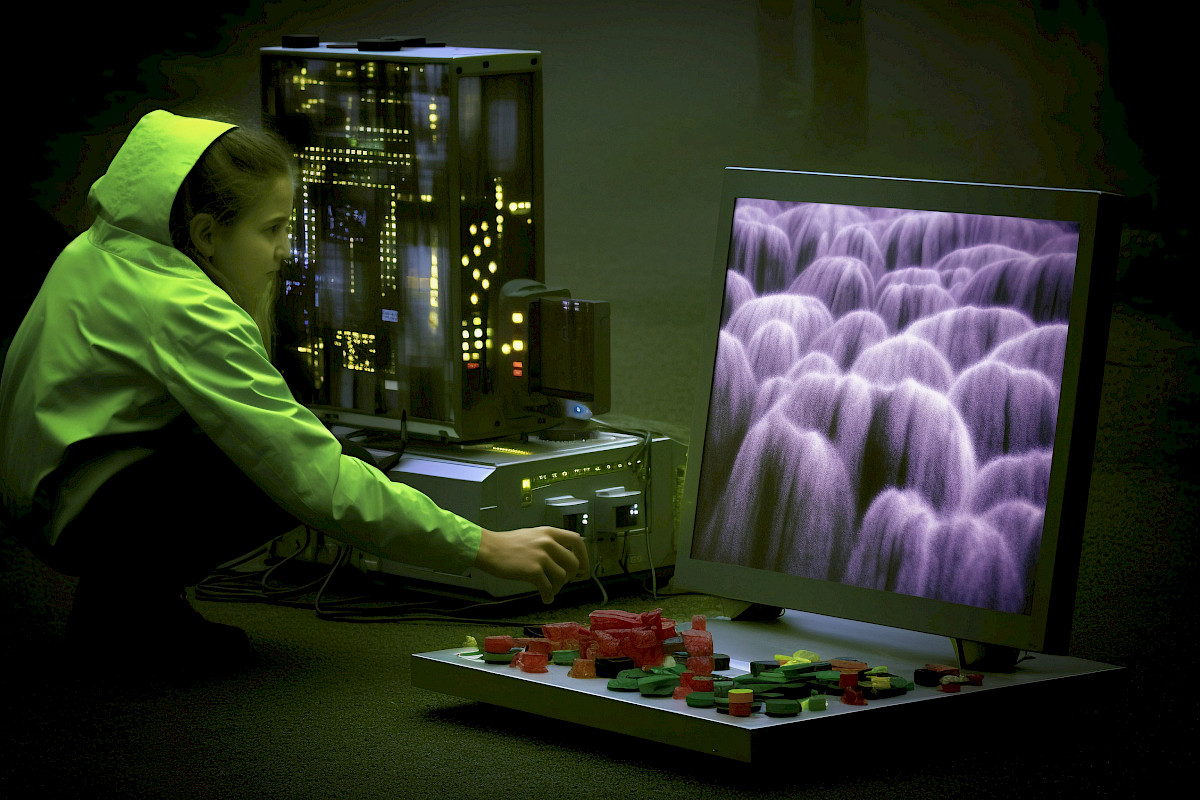
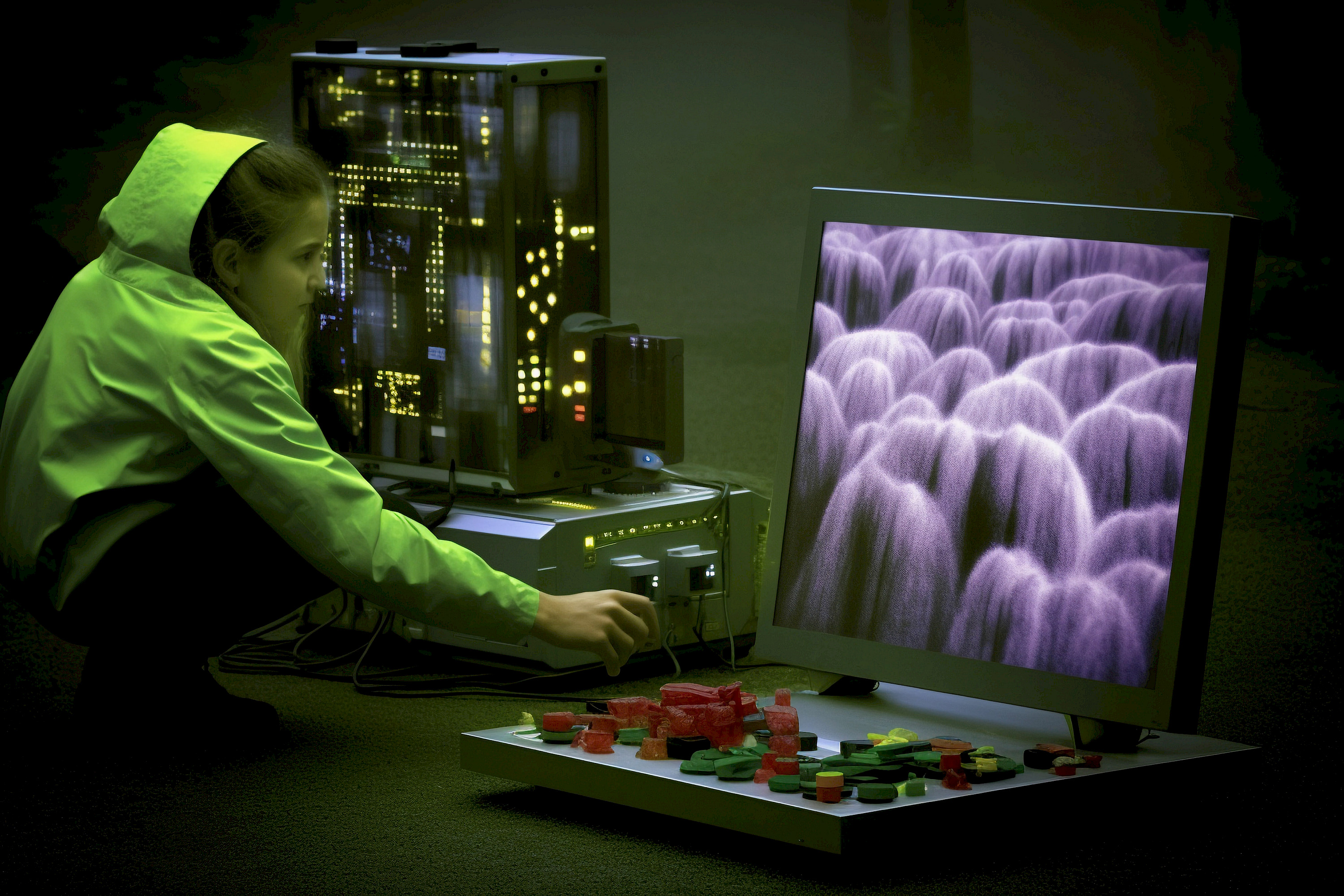
Magic and AI
A few months ago, I was lying in savasana at the end of a yoga class, doing my usual thing which is desperately trying not to fall asleep, when it came to me: AI is magic. This thought immediately was replaced with embarrassment at its inanity. Oversimplified and confused, but there was something to it: it appears to skip steps, like Alan Moore suggests magic does, and yet it is built on enormous datasets of human knowledge (tested and refined).
Magic’s hold on us is strong, and it seems to reappear in times of cultural upheaval. It can liberate and fascinate, draw us together, and help us tell stories about that which seems too big to truly grasp. As such, to the people who don’t understand it – and even to some of those who do – artificial intelligence seems to be bigger than it is, smarter than it is, somehow (all-)knowing. It is a rapidly developing technology with many facets and much bluster surrounding it. We are invited to admire and fear AI, while not knowing the full extent to which it has actually infiltrated our lives. The discrepancy between AI’s actual capabilities and those we attribute to it can lead to nowhere, a sense of disempowerment in the face of an ever-increasing reliance on AI tools.
This disempowerment is an intentional one, one that serves capitalism in an ever-accelerating race to devalue labour and control wealth and resources. The AI scholar Kate Crawford demonstrates in her seminal Atlas of AI that artificial intelligence (2) is neither artificial nor intelligent, but rather an intricate and inextricable agglomeration of Earth-based systems: natural resources, labour, politics, capital, social control. AI development is an earthbound process that is unendingly destructive: there are no contingency plans for managing harmful extraction processes, for what will happen when we run out of minerals like lithium. Furthermore, AI is both maintained by and furthers capitalist labour practices that were developed during the Industrial Revolution and refined throughout the 20th century, such as surveillance of workers, devaluation of labour and compartmentalisation of production into fragments of time and movement. It is utterly banal in that, while it is touted as a saviour of humanity by starry-eyed CTOs and software engineers, it is merely a tool for extracting precious data from human societies and figuring out how to use that data to the advantage of business-minded capitalists. In other words: “this is not magic; it is statistical analysis at scale.” (3) AI has more affinity with the decimation of indigenous knowledge and devaluation of women’s labour than the uplifting thereof as in some occult practices.
There is therefore a major ethical problem in calling AI magic. As Crawford notes:
The technique of ‘obscuring by mystification’ is often employed in public settings to argue for a phenomenon’s inevitability. We are told to focus on the innovative nature of the method rather than on what is primary: the purpose of the thing itself. Above all, enchanted determinism obscures power and closes off informed public discussion, critical scrutiny, or outright rejection. (4)
In other words, it’s no coincidence that AI’s mechanisms are veiled behind terms like ‘magic’ and even ‘intelligence’: again I note the power in naming. On being called what it isn’t, AI enters a no-man’s-land of responsibility. There, its developers, users or observers can, at best, shrug at its neutral inevitability, and at worst, wreak violence on the earth and its human and more-than-human populations in the name of progress.
But again, let’s sit with what AI is being called for a minute. Let us say that it is magic in the sense of an ‘alien’ power, and in the sense of an accumulation of human knowledge. If the first designation is intended to obscure AI’s harm, then the second is proof of the harm itself. I recently read that fan fiction writers in the United States have started trolling AI companies by creating a massive wave of content after they found out that LLMs were being trained on their fiction. (5) In the rush to develop this technology, tech companies consider the internet a free archive of human knowledge. They mine the spaces that have been freely accessible until this point (Reddit and other forums, and especially the creative productivity of fanfic and the commons) in the name of creating the best possible product.
In that name, AI is insatiable, gobbling up our knowledge archives. The consequences lie heavy on landscapes mined for lithium and rare earth minerals; on bodies and minds of people making unliveable wages in Amazon fulfilment centres or helping train AIs on Mechanical Turk; on people of colour falsely identified with inherently flawed facial recognition technology; on families singled out as likely to commit child welfare fraud due to the language they speak at home. (6) As Crawford asks: “What epistemological violence is necessary to make the world readable to a machine learning system?” (7) This question encapsulates the extraction and systematising of human knowledge (and creativity) to the benefit of the state and especially of corporations that develop and employ AI. It’s an inconceivably complex conglomeration of human-made systems that come together to form a technology that seems ethereal and neutral.
Warding off evil
Despite all this, to the non-expert, AI feels arcane and unknowable, so perhaps the best way to greet it and confront it is with arcane and unknowable tools. British artist James Bridle has done this very simply with his performance Autonomous Trap 001 (2017), in which a self-driving car is trapped in a salt circle taking the form of a no-passing lane divider. Salt circles are an ancient magical protector against whatever is conjured; no unearthly being can pass into (or out of) them. The self-driving car becomes both conjurer and demon, something advanced and powerful that can be tricked with human ingenuity and belief.
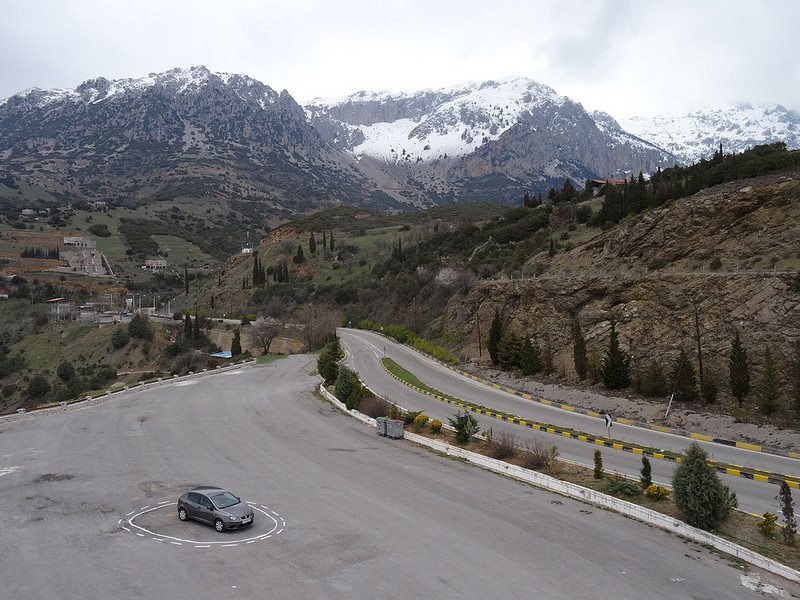
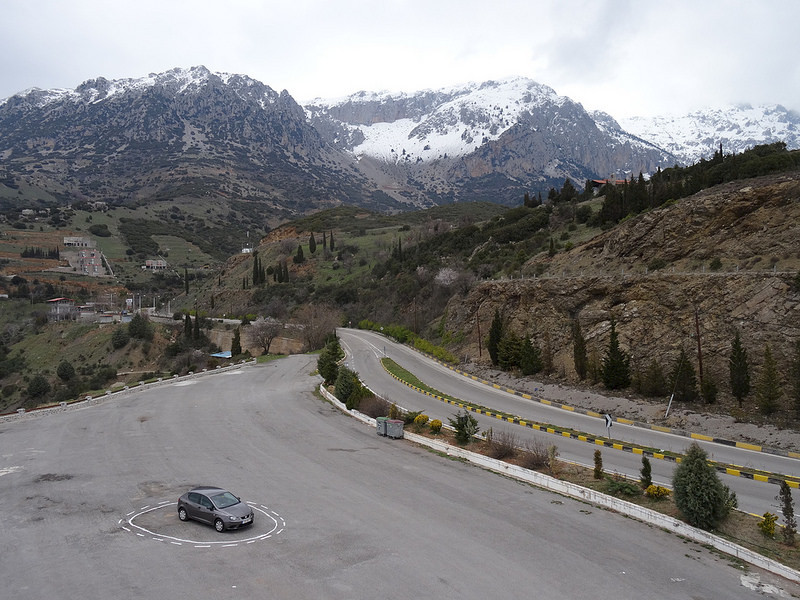
Step out of the salt circle for a moment to look at the interlocking rings we’ve now created. Artificial intelligence and magic come together in one space where neither has the upper hand: in art. We’ve reached a point where many artists, ever the innovators, use or engage with AI and magic as tools, collaborators, subjects and entities. They are able to occupy the precarious space where naivety and critique overlap.
To Moore, magic can only be – and will always remain – the purview of art. “It is with increasing rarity that we encounter artists of real stature, be they painter, writer or musician, who have not at some point had recourse to occult thinking”. (8) What fascinates me is that so many artists have met artificial intelligence with the occult or communed with the occult through artificial intelligence. It seems to be a natural pairing, and I’d like to examine it more closely. AI and magic are both technologies and tools designed as an enhancer of human abilities, and at the same time they are precarious and unpredictable extensions of human creativity and worldbuilding. We find ourselves in a time when magic can be associated with AI and other digital technologies, but it is also being used to harness, confront, and even attack or defend from AI.
What I want to demonstrate is that it makes a difference how a phenomenon is approached. In the case of magic and artificial intelligence, there is a great conflict brewing at their intersection. It’s in this naivety I’ve described: of thinking that something is magic because I don’t understand it. And at the same time, it’s in the way magic has been persecuted but also revived as an anti-capitalist, feminist reclamation of non-Cartesian knowledge (to borrow a phrase from the curator Aude Mgba).
Mystics of the Chthulucene
Alice Bucknell has noted this revival as the age of what they call the New Mystics. These are the artists who, armed with (or – against) new digital technologies and a healthy obsession with the occult, bridge the gap in our cultural understanding of power and its relation to knowledge production. The New Mystics have accepted the torch from the old mystics, the sages and seers and druids, and taken Prometheus’ fire to a humanity blinded by the dazzling pace of innovation. They don’t follow the rules of historical narrative or discipline, and if they say they are spellcrafters or cyberwitches, well, who’s to argue? What is a Mystic but a guide, a creative or collective “using the atmospheric potential of new technology to resurrect ancient belief systems bleached out of history, repositioning them as a powerful communal cipher into the present”? (9) To Bucknell’s New Mystics, AI is something of a familiar, a demon harnessed to the artistic process. I’d like to take this relationship into a more complicated space, one where ‘using the… potential of new technology’ to uncover eradicated knowledge is merely the by-product of the uncomfortable relationship artists maintain with AI. I propose that artists working with digital technology and magic are the Mystics of the Chthulucene, the wardens who safeguard knowledge that has withstood the violence of extraction and eradication. They recognise that the naivety that’s so tempting to give in to is a dangerous one. It’s joyous to be a mystic, but it’s painful to be so vigilant, too.
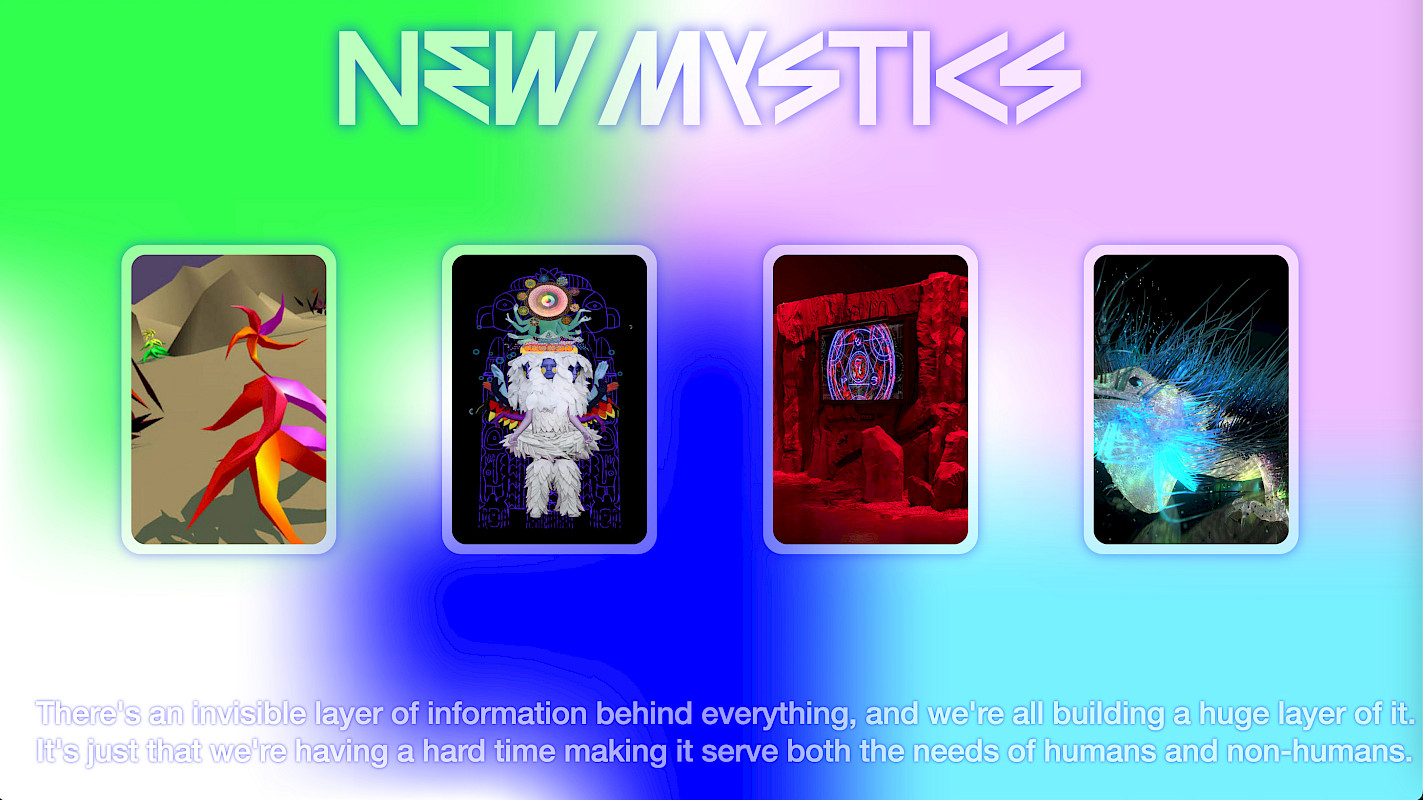
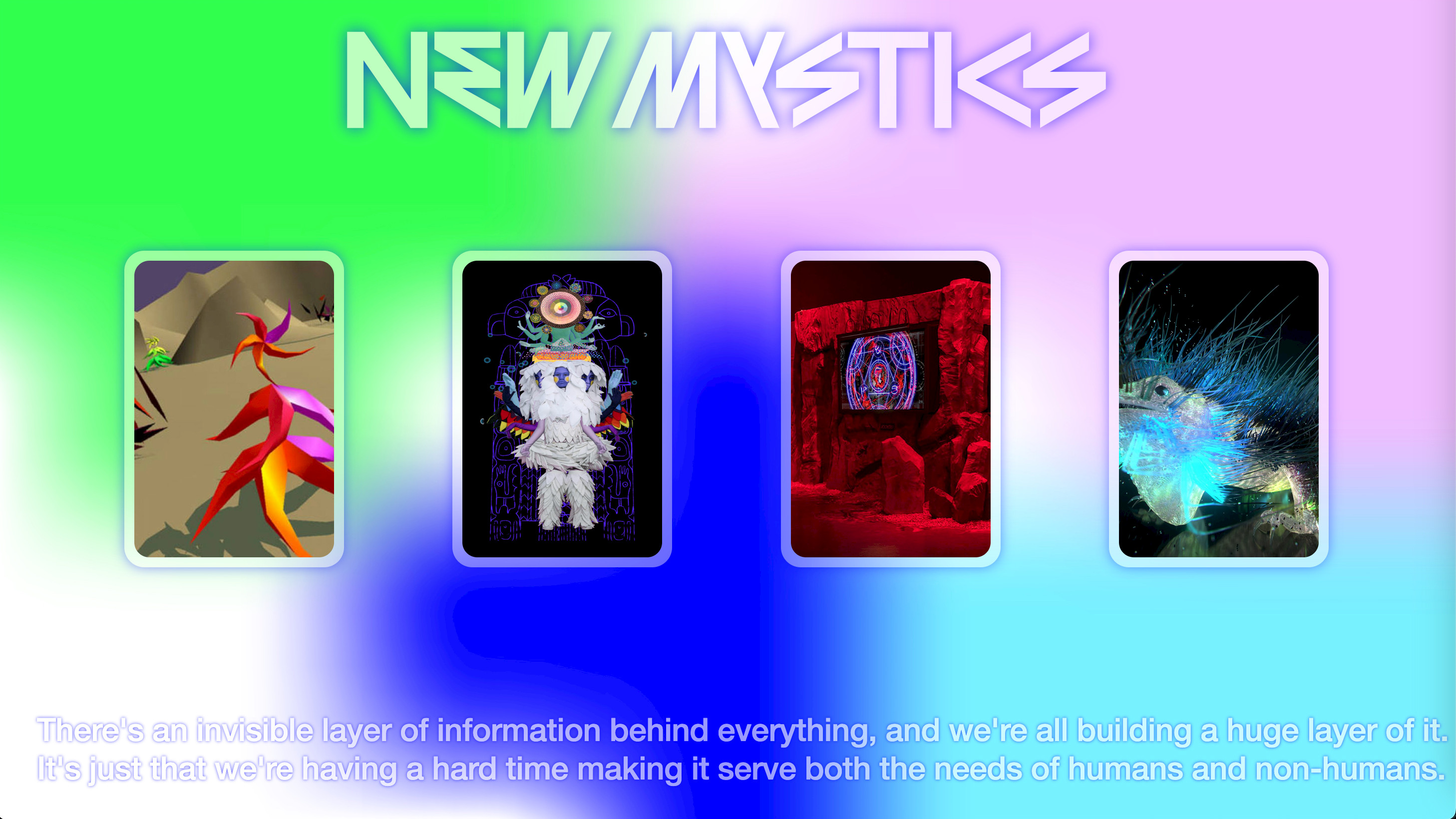
Take, for instance, the spellweaving of ‘digital witch’ Ginevra Petrozzi, who progressed from reading smartphones as Tarot into a practice of hacking our superstitions around recommendation algorithms to liberate women from the hold tailored ads have on them. The magic Petrozzi practices is one of infiltration; she harnesses and reverses the algorithm’s psychic power in an act of affirmative curse-breaking. Or Morehshin Allahyari, who coined the term ‘digital colonialism’ to demonstrate the reproduction of colonial violence as cultural artefacts destroyed by ISIS are appropriated by Western art institutions through the act of 3D scanning for posterity and preservation. Calling 3D scanners objects of witchcraft (and therefore neutral objects that take on the intention of their user), Allahyari creates a methodology for safeguarding the significance and power of lost artefacts from the colonial, sterilising gaze of the museum.
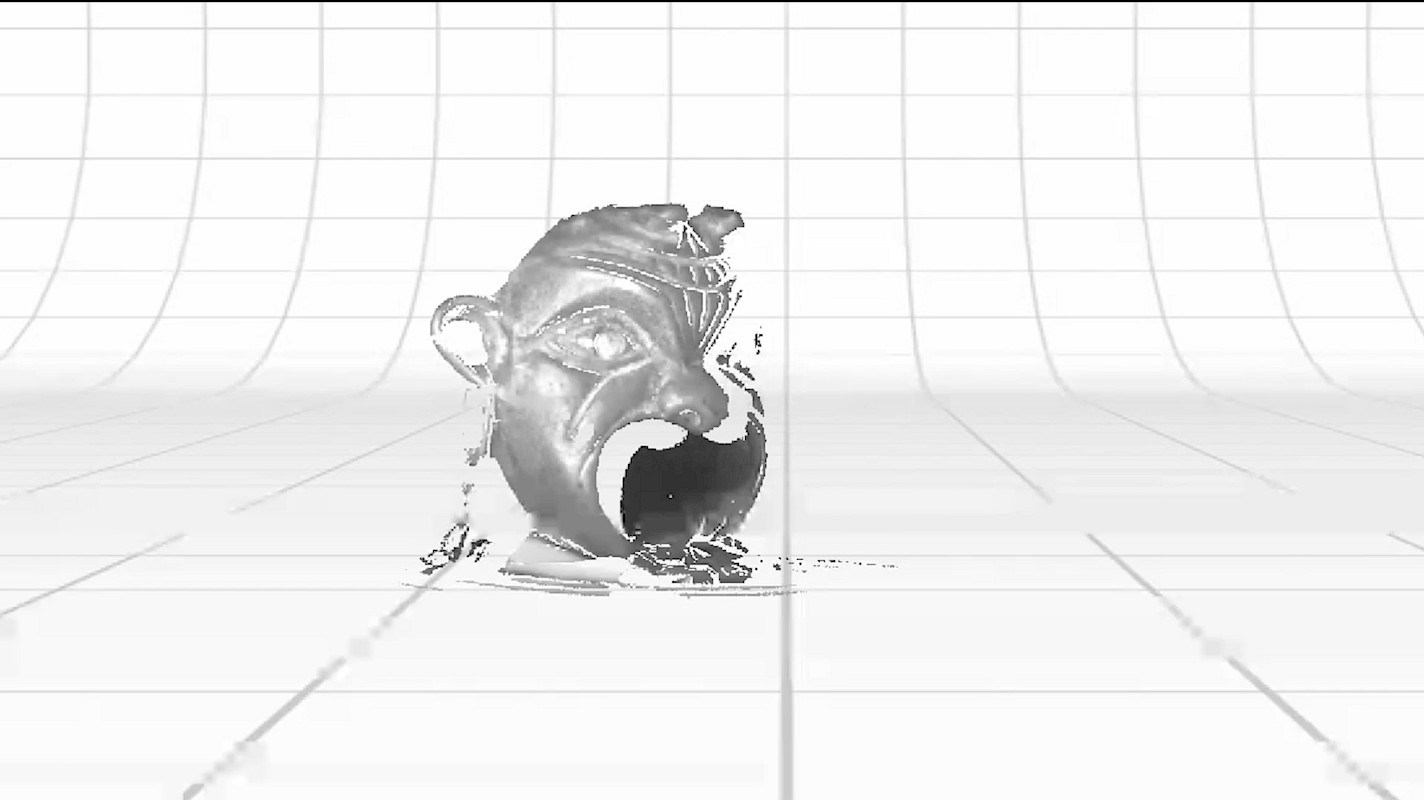
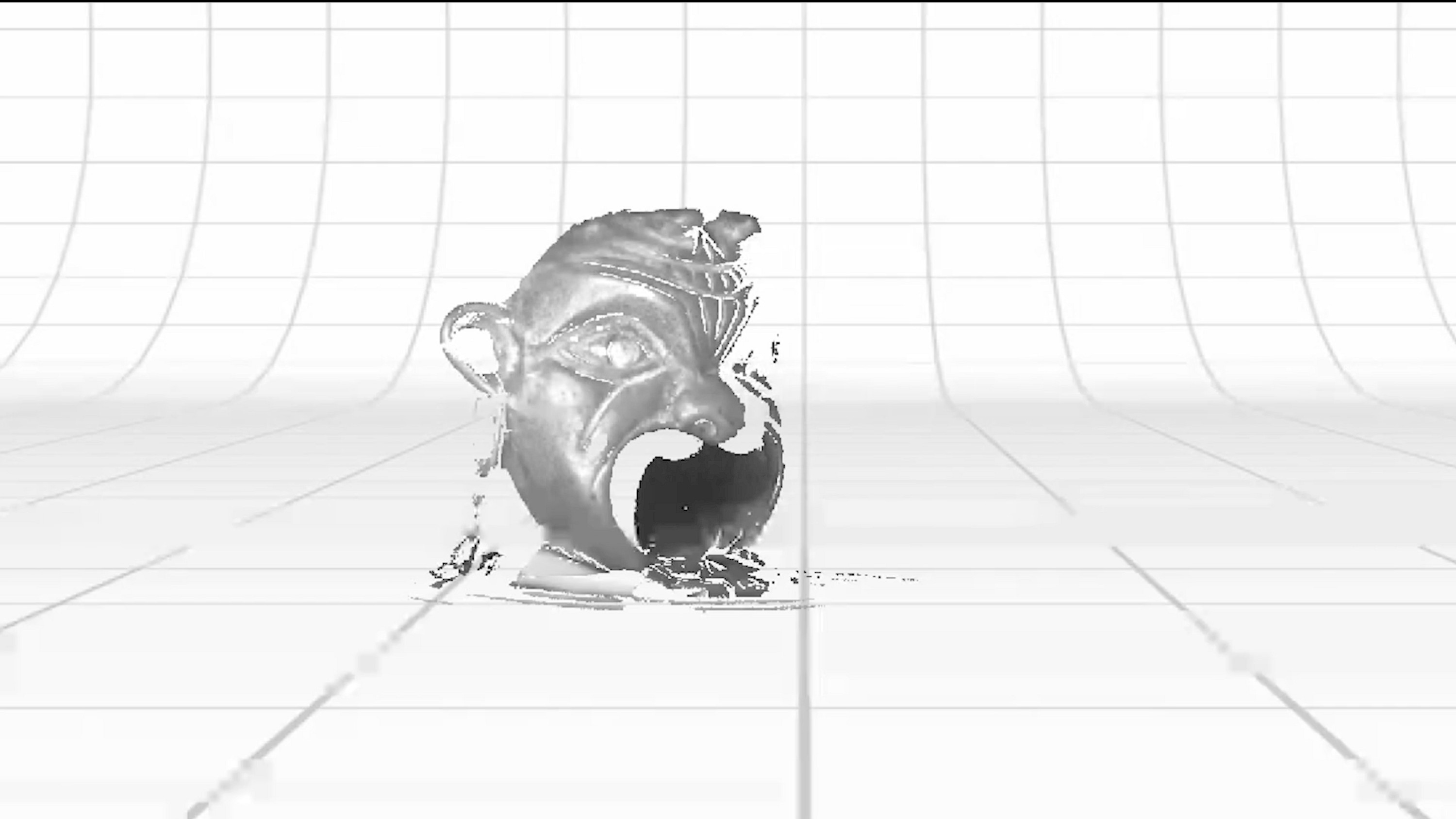
The development of vast databases full of labelled images and text that make up much of what AIs are trained on has been a process with origins in 19th century phrenology and other pseudosciences that attach meaning (affect) to images along gendered and racialised lines. (10) Mimi Onuoha perhaps does not categorise herself amongst practitioners of magic, but as a keeper of knowledge against the tidal wave of AI, she’s a wise woman at the very least. Her project The Library of Missing Datasets (2015-2022) acts as an archive of knowledge omitted from the datasets upon which AI models are trained. Onuoha notes that “within many spaces where large amounts of data are collected, there are often empty spaces where no data live.” (11) Data such as “Firm statistics on how often police arrest women for making false rape reports”; “Sales and prices in the art world”; “Undocumented immigrants currently incarcerated and/or underpaid”… (12): this is not missing knowledge, because it certainly exists: but it is not collected. Onuoha both questions the right of the state to have this information and acts as a sentinel against the total snuffing out of the knowledge that it does not behove the state to know. She is creating an imaginary, a new sort of AI trained on data gathered with care and consent, the only sort that can actually be used for good.
This rather grandiose title I give these artists derives from philosopher Donna Haraway’s proposed term Chthulucene, an alternate to the geological age many scholars call the Anthropocene. The Anthropocene, to Haraway, is finite, in that, when it ends, humanity will end as well. And anyway, she argues, it’s human-centric and managerial – unable to contain the complex systems and multiplicities we face as only one (extremely destructive) lifeform on this planet. (13) The Chthulucene, on the other hand, names our planet Gaia, a powerful and retaliatory yet completely impartial being. The Greek work chthonios, meaning ‘of, in or under the Earth and seas’ pulls the camera back, allowing us to see a more complex, chaotic, but ultimately (hopefully) cathartic picture of our time on Earth. This complexity is what Haraway calls tentacular: Medusan, snaking tendrils of reality that can both cause total chaos and disorganisation – or can turn us to stone.
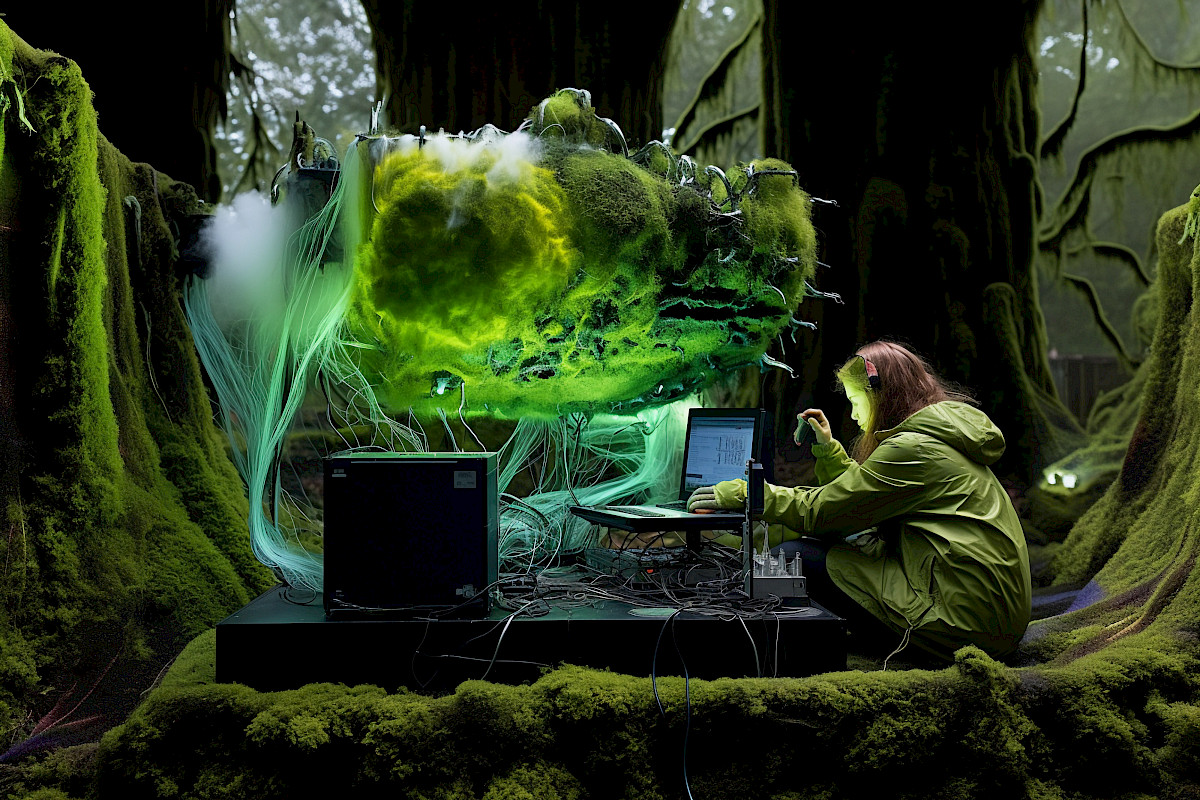
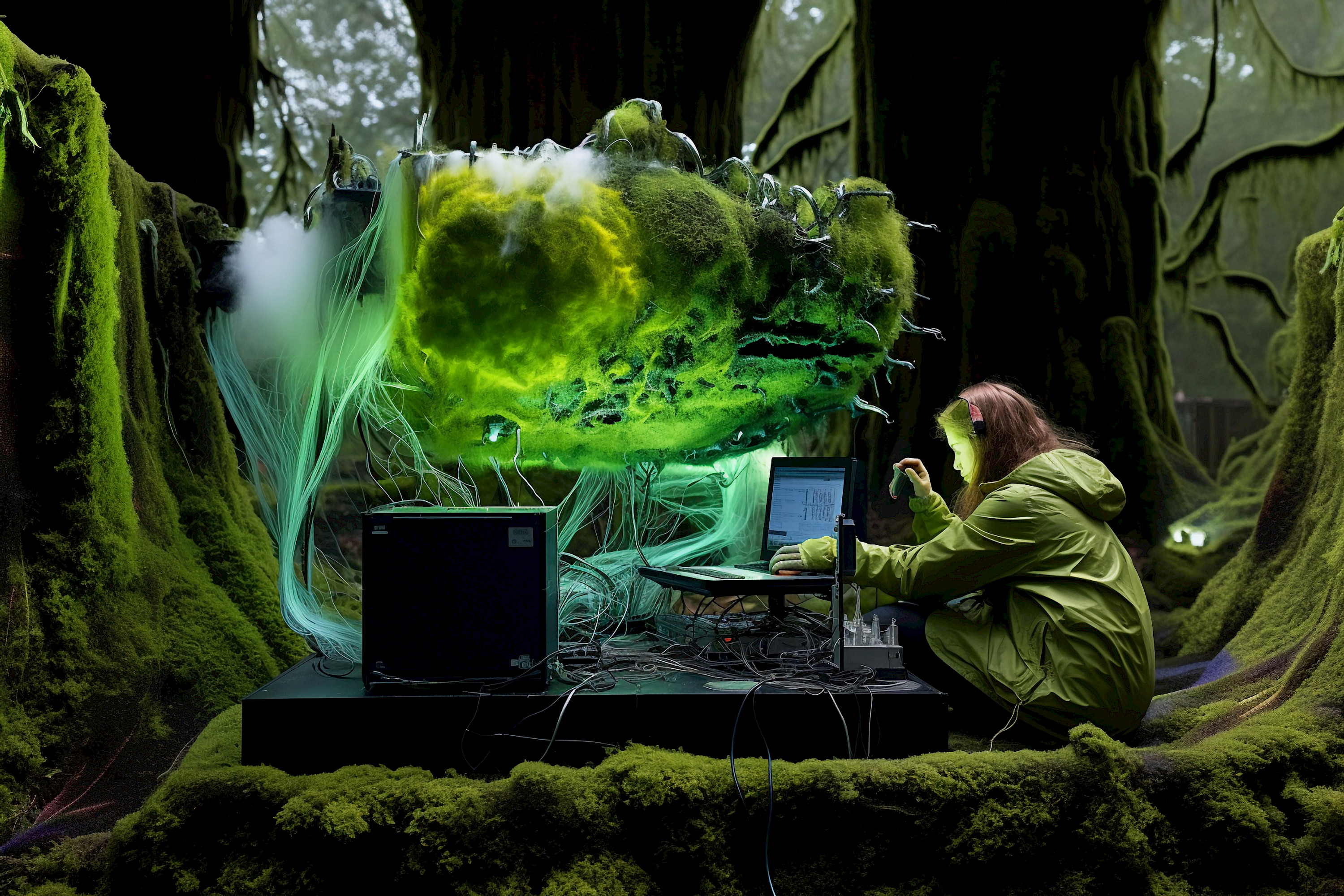
Thus, the Chthulucene is a precarious era, but Earthbound. It implies that we must focus our attention on the planet we live on and all its inhabitants. In that sense it is fascinatingly opposed to Octavia Butler’s proposal to leave Earth in Parable of the Sower. The Chthulucene also makes plenty of room for speculation, myths, and magic: though Haraway claims it is not a ‘sacred’ era, it is precisely sacred in that “We are at stake to each other” in the Chthulucene. (14) Myths and folklore tell stories of how communities are made, broken and repaired. The Chthulucene is not mythical (since it can be seen as real) but it necessitates mythmaking and storytelling to begin repair and reparations. Finally, the Chthulucene is ideally suited to recognizing the role the digital world plays in our lives, and the roles that we will take on in new virtual realms. Cthulhu – H.P. Lovecraft’s science fiction monster – lurks under the surface of the ocean as an elemental deity. We must wonder what lurks beneath the surface of the systems known as AI.
Where do we go from here?
Recently, the astrology app company Co-Star released a new experience at Iconic Magazines in New York City. It’s a big, retro-looking machine, powered by AI, that answers questions like “What are my red flags?” and “Should I start a cult?” using ChatGPT and GPT-3, printing the results on receipt paper. (15) Of course, it blew up on TikTok, a savvy marketing gimmick that feeds the Gen-Z beast. While everyone knows it’s bogus, and ‘real’ astrologers claim that it is even harmful, Co-Star’s machine exposes the hold that AI has taken in the magical practices that cling to culture. We have somehow agreed that AI is able to channel power but have no wherewithal to meet it with energy and collective action.
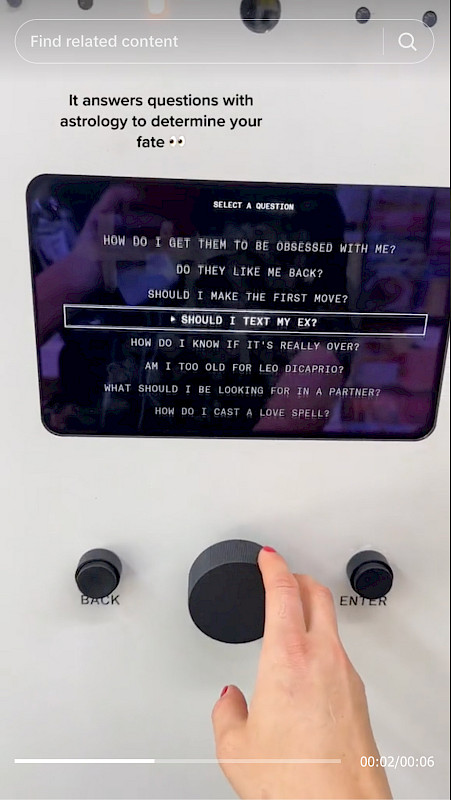
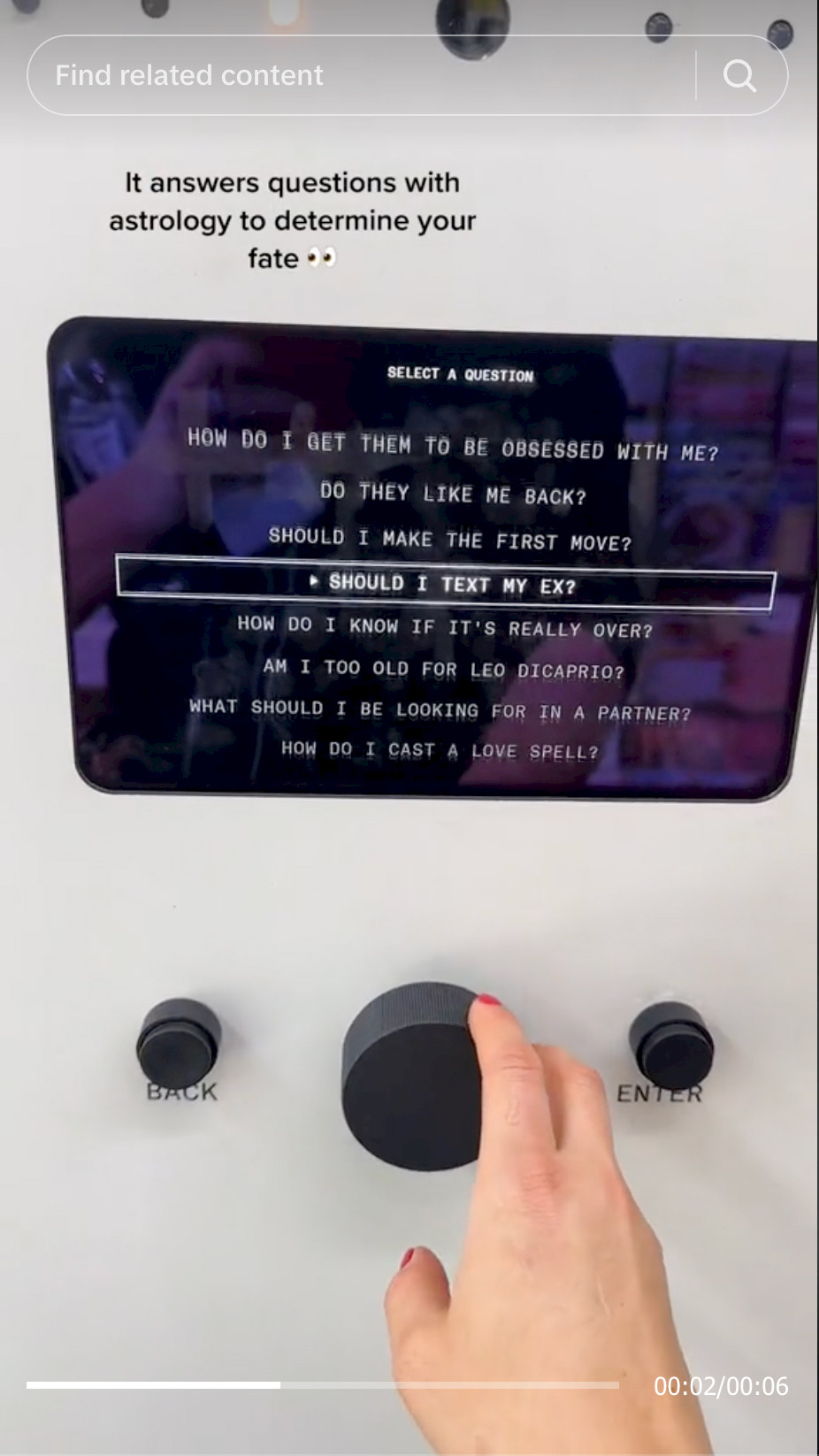
It’s as though the agglomeration of human knowledge that AI is fed on somehow expands past its own limits, teaching itself and doing the unexpected, making it unmanageable and slippery. What artists like Alice Bucknell’s New Mystics (or the Mystics of the Chthulucene, if you’ll indulge me) do is show us that there is real magic to be practiced in our response to the blinding pace of AI’s expansion into every aspect of our societies. Not to be dramatic, but they’re basically warding off evil, ok?
1. Alan Moore, “Fossil Angels”, excerpt in MAGIC, ed. Jamie Sutcliffe (London and Cambridge: Whitechapel Press and MIT Press, 2021), 46.
2. By the way, I use artificial intelligence here as a catch-all term for systems such as LLMs (large language models like ChatGPT), GANs (generative adversarial networks), neural networks, machine learning, etc.
3. Kate Crawford, Atlas of AI (New Haven and London: Yale University Press, 2021), 215.
4. Crawford 214.
5. Amanda Silberling, Fan fiction writers are trolling AIs with Omegaverse stories, techcrunch.com, 13.06.2023.
6. Melissa Heikkilä, “Dutch scandal serves as a warning for Europe over risks of using algorithms,” POLITICO, 29.03.2022.
7. Crawford 221.
8. Moore 48.
9. Alice Bucknell, “The New Mystics: High-Tech Magic for the Present”, excerpt in MAGIC, ed. Jamie Sutcliffe (London and Cambridge: Whitechapel Press and MIT Press, 2021), 149.
10. See: Crawford, Atlas of AI, Chapter Five: Affect.
11. Mimi Onuoha, https://github.com/MimiOnuoha/missing-datasets.
12. Ibid.
13. Donna Haraway, “Tentacular Thinking: Anthropocene, Capitalocene, Chthulucene,” e-flux #75 (09.2016).
14. Ibid.
15. Saam Naimi, “Is A.I. the Future of Astrology?” New York Times, 4.07.2023.
